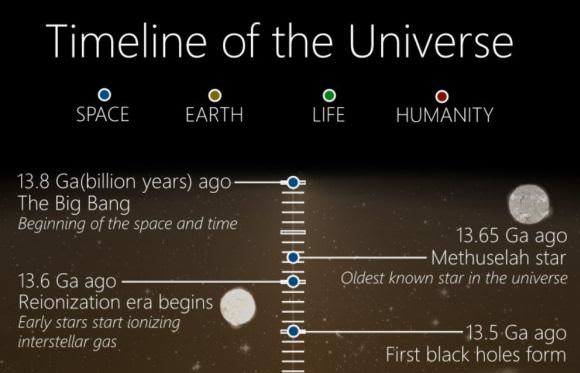Don’t know much about history? How about the future? A new infographic by graphic designer Martin Vargic portrays both past and forthcoming events in our Universe, from the Big Bang to the death of our Sun. The graphic is color-coded and shows “significant events in cosmic and natural history.” It also illustrates how briefly humanity has been part of the scene.
Fun future events are when Earth’s day will become 25 hours long (Earth’s rotation is slowing down), and the amazingly distant time when the Solar System finally completes one orbit around the galactic core.
The full infographic is below, and be prepared to give your scroll wheel a workout. This thing is huge, but very comprehensive for covering about 23.8 billion years!
Vargic also has created free apps of this timeline available (links to Android and iOS) which enable “anyone to explore the past and future of the world in a swift, clean and coherent fashion.”
We recently featured Vargic’s visualization of exoplanets. He’s also done a very cool Map of the Internet, a map of how the the constellations have changed over time and visualization of the Moon replaced with other bodies, as well as a wide variety of other maps and infographics. You can check out his work on his website, Halcyon Maps. He puts out new graphics each week.
Without further ado, here is the history — and future — of the Universe:



Axial tilt reverses? Citation please?
11 Gya temperature = 13,000K??? Oh come on…
I agree. Such a cosmic temperature seems more likely BEFORE the first galaxies and stars form and BEFORE the CMB radiation origin event which is not found on the timeline.
There seem to be several other errors and significant omissions in the timeline.
I hope the forecasted axial tilt ‘reversal’ is some kind of confusion with a magnetic pole reversal as I find no substantiation for a ‘reversal’ of the Earth’s axial tilt, whatever that could be.
There is a ‘wander’ of the axis over geologic time but what would constitute a ‘reversal’?
The inclusion of such a dubious forecast casts a pall over the entire graphic. I would have liked to share it with others but with that glaring error as the first forecasted event after the ‘present’ I feel I cannot vouch for the accuracy of any of its content.
A few slight problems,
The sun will have lost one half of its mass to the “solar wind”, by the time the sun becomes a red giant,
and thus the earth’s orbit will have a larger diameter,
even when it is corrected for the effect of the earth colliding with particles in the solar wind.
Most writers forget to add this factor when writing about the future possibility of the sun annihilating the earth.
The precession (free nutation) of the earth’s axis (Chandler Wobble) is now about 9 meters,
and it does not reach the scale where it could invert the earth’s axis under any continental drift scenario that I know about.
The Eemian interglacial (130,000 to 115,000 years ago) period is not included.
During this period, the global warming was so severe that it reached 8 degrees Celsius above today’s temperatures,
and managed to melt a lot of the ice off of southern Greenland.
So, I would set the start of the last ice age at 110,000 years ago.
I am waiting for version 2.0
The idea is great.
Whoo! What a story! What an adventure!
———-
Something similar: “Timescales in Open, Flat, and Very Large Closed Universes”, and archived at: http://www.oocities.org/dreamer-71/timescales.html is a bit dated, but just as interesting (and more oriented towards astro-physical events.
can’t see shi
right click on the broken image, save as…
The comments here seem to call the reliability of the timeline into question. What I would like to see is informed discussion of all disputable items culminating in a second edition.
Whether or not temperatures 11 Ga ago averaged 13000 K, “Universe starts to cool” is meaningless, right? What is the real significance of that date?
One thing I learned (or had never thought about before) was how much change the Milky Way saw during its formation. According to the timeline, the galaxy itself began forming 12.6 Ga ago and its disk 8.8 Ga ago. It began spiralising 6.5 Ga ago and completed the process (whatever that means) 5.5 Ga ago, not long before the formation of the Sun 4.57 Ga ago. Meanwhile, the oldest known spiral galaxy (11.7 Ga ago) and the universe cooling to the point of habitability (10.4 Ga ago) happened after the initial formation of the galaxy but before the formation of the disc, and the universe’s expansion started to accelerate (6 Ga ago) while the Milky Way was in the process of forming its spirals.
I didn’t know that.
Checked Google Play – it’s listed with Halcyon Apps